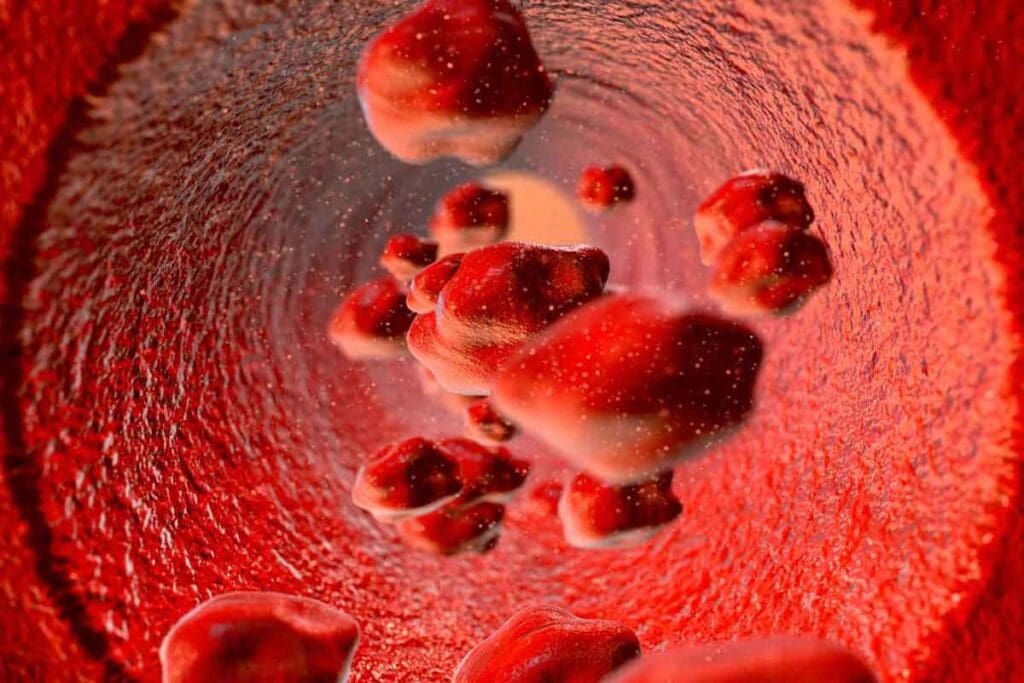Last Updated on November 17, 2025 by Ugurkan Demir
Many women experience menstrual blood clots. These clots form when blood pools and coagulates before leaving the body. They can look like jelly-like masses, ranging from bright red to dark brown. They are usually made of coagulated blood or tissue from the uterus.

At Liv Hospital, we know how important it is to understand the types of blood clots during periods. We also look for signs of endometriosis, which can cause these clots. Knowing about menstrual clots can help ease worries and improve health.
Menstrual clotting is a natural process. But, knowing what’s normal and what’s not is key. This helps spot health issues early.
Clots form when menstrual flow is heavy. The body’s anticoagulants can’t keep up. These clots are small, gelatinous masses of blood.
When the uterus sheds its lining, it releases blood and tissue. Heavy flow can cause blood to clot. Clots smaller than a quarter are common and usually harmless. But, larger clots or those with tissue might mean there’s a problem.

It’s important to know the difference between normal and abnormal clotting. Normal clots are small and happen during heavy flow days. But, abnormal clotting can signal issues like endometriosis, fibroids, or hormonal imbalance.
These signs might mean there’s a health problem. Knowing the difference helps women spot issues early.
Menstrual clots are made of coagulated blood, tissue, and other cellular material. The exact makeup depends on the person’s menstrual flow and health.
Clots might have visible tissue, which is sometimes normal. But, if there’s a lot of tissue or other symptoms like severe pain or heavy bleeding, it’s time to see a doctor.
Understanding what menstrual clots are made of helps women monitor their health. They can seek medical help when needed.
Menstrual blood clots, often bright red, offer insights into a woman’s health. These clots are common during menstruation and can look different.
Bright red clots show up at the start of your period. They’re linked to a heavier flow and look like gelatinous masses or clots. The color is bright red because the blood is fresh.
Clot sizes vary, and they’re usually normal if not too big. They shouldn’t cause severe pain or heavy bleeding.
Bright red clots mean you might have a faster menstrual flow. Quick uterus contractions shed the lining fast, leading to fresh clots. This is common in women with heavier flows.
While bright red clots are usually okay, some signs are not. Large clots, heavy bleeding, or severe pain are red flags. You should see a doctor.
Knowing about bright red clots helps women understand their menstrual health. It tells them when to get medical help.
Menstrual blood can change in color and texture. Dark brown clumpy blood is common. It happens because of how long the blood takes to leave the body.
Dark red or brown clots form when blood takes longer to leave the body. This makes the blood darker as it mixes with air. Clumps happen because of blood mixing with tissue and menstrual fluid.
Several things can make period blood turn dark brown and clumpy. Old blood is a big reason. As blood stays in the uterus, it changes color, like iron rusts in air.
Brown clotting can be caused by many things, including:
These issues can change how menstrual blood flows and clots.
Some brown clotting is normal, like at the start or end of your period. But big or frequent clots might mean a problem. Watch the size, how often they happen, and any symptoms.
If you have heavy bleeding, a lot of pain, or big clots often, see a doctor. They can check if there’s a health issue that needs help.
Seeing grey or white tissue in menstrual blood can be scary. But knowing why it happens can ease your worries. This is because the uterine lining is shedding during your period.
The uterine lining, or endometrial tissue, is full of blood vessels and glands. When it’s shed, it looks like grey or white bits in your blood. It’s important to spot this tissue to understand your menstrual health.
This tissue can look stringy, clumpy, or even like a membrane. Sometimes, it comes with blood clots. These clots can be grey, white, or even dark brown.
Many things can lead to grey blood clots or tissue during your period. Hormonal shifts, uterine issues, and some health problems can make the uterine lining shed differently.
Seeing grey or white tissue in your blood is usually normal. But sometimes, it means you should see a doctor. If you have heavy bleeding, severe pain, or irregular periods, get medical help.
Also, if you notice odd smells, fever, or if the tissue looks different, see a doctor right away.
Pinkish blood clots during a light menstrual period are something to look into. Many think clots only happen with heavy flows. But, clots can also show up during lighter periods, causing worry.
Several reasons can cause light periods with clots. Hormonal imbalances, like changes in estrogen and progesterone, can affect how much blood flows and clotting. Uterine obstructions, like polyps or fibroids, can also cause clots, even with lighter periods.
Another key factor is the shedding of the uterine lining. If this lining sheds unevenly or in big pieces, it can lead to clots, even if the flow is light.
The link between menstrual flow volume and clotting is not simple. It might seem that heavier flows would lead to more clots. But, clots can also appear during light periods, showing there are other factors at work. Clotting is not just about how much blood flows. It also depends on how well the body can manage and clear the menstrual flow.
| Factor | Impact on Clotting |
| Hormonal Imbalance | Affects menstrual flow and clot formation |
| Uterine Obstructions | Can cause clotting even during light periods |
| Uterine Lining Shedding | Uneven shedding can lead to clot formation |
Uterine obstructions, like fibroids or polyps, can greatly affect clotting, even in light periods. These obstructions can mess with normal menstrual flow, causing clots. It’s important for those with ongoing or concerning clotting to see a healthcare provider to check for any obstructions.
“Understanding the causes of menstrual clots, even in light periods, can help ease worries and guide the right medical check-ups when needed.”
By looking into the reasons and factors behind pinkish blood clots in light periods, people can better understand their menstrual health. They can also seek the right care when needed.
Understanding the link between endometriosis, ovarian cysts, and menstrual clots is key for women’s health. These conditions can cause heavy menstrual bleeding and blood clots. We’ll look at how endometriosis and ovarian cysts affect menstrual clotting and what signs might show these conditions.
Endometriosis is when tissue like the uterus lining grows outside the uterus. This causes pain and discomfort. The misplaced tissue bleeds and sheds with hormonal changes, leading to heavy menstrual bleeding and clots.
Clots from endometriosis are often bigger and more common. They can also cause severe pelvic pain, painful urination, or bowel movements during menstruation. These symptoms, along with clots, can indicate endometriosis.
Ovarian cysts are fluid-filled sacs on the ovaries that can change menstrual bleeding. Some cysts, like those that rupture, can cause heavy bleeding and clots. It’s important to watch menstrual health for signs of problems.
| Condition | Impact on Menstrual Bleeding | Characteristics of Clots |
| Endometriosis | Heavy, prolonged bleeding | Large, frequent clots; possibly with tissue |
| Ovarian Cysts | Irregular, possibly heavy bleeding if cyst ruptures | Variable size; may be accompanied by pain |
Women with unusual menstrual clots or heavy bleeding should see a healthcare provider. They can find out the cause.
Large blood clots and tissue masses in menstrual flow are serious signs. They might mean you’re bleeding too much. This could be due to many reasons.
Clots bigger than a quarter or that make sanitary products soak up fast are big worries. Seeing these clots often means you might have a health issue that needs a doctor’s look.
Many things can lead to big clots and tissue masses during your period. These include:
If you keep seeing big clots or they come with pain, a lot of bleeding, or fever, see a doctor fast. These could be signs of a problem that needs treatment. It’s best to talk to a healthcare provider to figure out what’s going on and how to fix it.
Knowing what causes these clots and recognizing the signs can help you get the right help. We’re here to support and guide you on your health journey.
Understanding menstrual blood clots is key for women’s health. We’ve looked at the different types of clots and what they mean. While small clots are normal, big or frequent ones might need a doctor’s visit.
Knowing when to get medical help is important. If you have big clots or severe pain, see a doctor. They can check for problems like fibroids or hormonal issues.
Clots can signal health problems, so knowing when to act is vital. By staying informed and proactive, women can manage their menstrual health better. We urge women to watch their cycles and seek medical help when needed.
Menstrual blood clots are made of blood, tissue, and other materials shed from the uterus. They can vary in size, color, and consistency.
Bright red blood clots might mean you’re having a heavy period. They can be normal, but might also show a problem like fibroids or hormonal issues.
Dark brown clumpy blood happens when blood takes longer to leave the uterus. This lets it oxidize and change color. It’s usually normal, but might also hint at issues like endometriosis.
Passing grey or white tissue is normal when shedding the uterine lining. But, if it’s with heavy bleeding or pain, it might mean there’s a problem that needs a doctor’s look.
Yes, endometriosis can mess with menstrual bleeding and clotting. Women with it might have heavier or longer bleeding, leading to bigger or more frequent clots.
Big or frequent clots, heavy bleeding, or clots with pain or fever are signs of a problem. You should see a doctor.
Yes, ovarian cysts can affect menstrual bleeding and clotting. They can change hormone levels and menstrual flow, leading to clotting changes.
See a doctor if you have heavy or long bleeding, big or frequent clots, or clots with pain or fever.
Managing clots means understanding their causes and fixing any problems. This might include hormonal treatments, lifestyle changes, or other ways to control bleeding and clotting.
Subscribe to our e-newsletter to stay informed about the latest innovations in the world of health and exclusive offers!